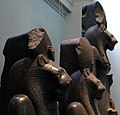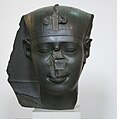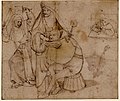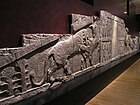ബ്രിട്ടീഷ് മ്യൂസിയം
ലണ്ടനിലെ ബ്ലൂംസ് ബെറിയിൽ Bloomsbury -സ്ഥിതിചെയ്യുന്ന മനുഷ്യചരിത്രത്തിനും കലയ്ക്കും സംസ്കാരത്തിനുമായി സമർപ്പിക്കപ്പെട്ടിട്ടുള്ള ഒരു പൊതു സ്ഥാപനമാണ് ബ്രിട്ടീഷ് മ്യൂസിയം - The British Museum. ഇവിടുത്തെ സ്ഥിരം ശേഖരം തന്നെ ഏതാണ്ട് 80 ലക്ഷത്തിൽ അധികം എണ്ണം വരും.[3] ഏറ്റവും വലിയ മ്യൂസിയങ്ങളിൽ ഒന്നാണിത്[3]
 | |
| സ്ഥാപിതം | 1753 |
|---|---|
| സ്ഥാനം | Great Russell Street London, WC1B United Kingdom |
| നിർദ്ദേശാങ്കം | 51°31′10″N 0°07′37″W / 51.5195°N 0.1269°W |
| Collection size | approx. 8 million objects[1] |
| Visitors | 5,906,716 (2017)[2]
|
| Chairman | Sir Richard Lambert |
| Director | Hartwig Fischer |
| Public transit access | |
| വെബ്വിലാസം | britishmuseum.org |
| Area | 807,000 sq ft (75,000 m2) in 94 Galleries |

ചരിത്രം
Hans Sloane

Foundation (1753)
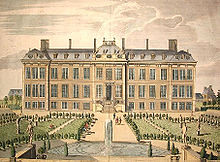
Cabinet of curiosities (1753–78)

Indolence and energy (1778–1800)

Growth and change (1800–25)


The largest building site in Europe (1825–50)

Collecting from the wider world (1850–75)
Scholarship and legacies (1875–1900)
New century, new building (1900–25)


Disruption and reconstruction (1925–50)
A new public face (1950–75)

The Great Court emerges (1975–2000)
The British Museum today
Governance
Building
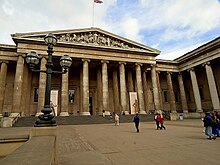


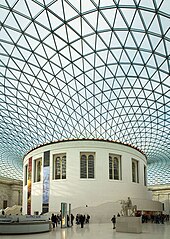

Departments
Department of Ancient Egypt and Sudan

Key highlights of the collections include:


Predynastic and Early Dynastic period (c. 6000 BC – c. 2690 BC)
- Mummy of Ginger from Gebelein, (c. 3400 BC)
- The Battlefield Palette and Hunters Palette, two cosmetic palettes with complex decorative schemes, (c. 3100 BC)
- Stela of King Peribsen, Abydos, (c. 2720–2710 BC)
Old Kingdom (2690–2181 BC)
- Granite statue of Ankhwa, the shipbuilder, Saqqara, Egypt, 3rd Dynasty, (around 2650 BC)
- Several of the original casing stones from the Great Pyramid of Giza, one of the Seven Wonders of the Ancient World, (c. 2570 BC)
- Wooden tomb statue of Tjeti, Fifth to Sixth Dynasty, (about 2345–2181 BC)
Middle Kingdom (2134–1690 BC)
- Inner and outer coffin of Sebekhetepi, Beni Hasan, (about 2125–1795 BC)
- Limestone stela of Heqaib, Abydos, Egypt, 12th Dynasty, (1990–1750 BC)
- Block statue and stela of Sahathor, 12th Dynasty, reign of Amenemhat II, (about 1922–1878 BC)
New Kingdom (1549–1069 BC)
- Fragment of the beard of the Great Sphinx of Giza, (14th century BC)
- Colossal head from a statue of Amenhotep III, (1350 BC)
- Colossal limestone bust of Amenhotep III, (1350 BC)
- Amarna Tablets, 99 out of 382 tablets found, second greatest collection in the world after the Vorderasiatisches Museum, Berlin (203 tablets), (1350 BC)
- List of the kings of Egypt from the Temple of Ramesses II, (1250 BC)
Third Intermediate Period (1069–664 BC)
- Mummy case and coffin of Nesperennub, Thebes, (c.800 BC)
- Statue of Amun in the form of a ram protecting King Taharqa, (683 BC)
- Inner and outer coffins of the priest Hor, Deir el-Bahari, Thebes, 25th Dynasty, (about 680 BC)
Late Period (664–332 BC)
- Saite Sarcophagus of Satsobek, the vizier (prime minister) of the northern part of Egypt in the reign of Psammetichus I, (664–610 BC)
- Bronze figure of Isis and Horus, North Saqqara, Egypt, (600 BC)
- Obelisks and sarcophagus of Pharaoh Nectanebo II, (360–343 BC)
Ptolemaic dynasty (305–30 BC)
- The famous Rosetta Stone, trilingual stela that unlocked the ancient Egyptian civilisation, (196 BC)
- Giant sculpture of a scarab beetle, (32–30 BC)
- Mummy of Hornedjitef (inner coffin), Thebes, (3rd century BC)
Roman Period (30 BC-641 AD)
- The Meriotic Hamadab Stela from the Kingdom of Kush found near the ancient site of Meroë in Sudan, 24 BC
- Lid of the coffin of Soter and Cleopatra from Qurna, Thebes, (early 2nd century AD)
- Mummy of a youth with a portrait of the deceased, Hawara, (100–200 AD)
- Room 64 - Egyptian grave containing a Gebelein predynastic mummy, late predynastic, 3400 BC
- Room 4 – Three black granite statues of the pharaoh Senusret III, c. 1850 BC
- Room 4 – Three black granite statues of the goddess Sakhmet, c. 1400 BC
- Room 4 – Colossal statue of Amenhotep III, c. 1370 BC
- Great Court – Colossal quartzite statue of Amenhotep III, c. 1350 BC
- Room 4 - Limestone statue of a husband and wife, 1300-1250 BC
- Room 63 - Gilded outer coffins from the tomb of Henutmehyt, Thebes, Egypt, 19th Dynasty, 1250 BC
- Book of the Dead of Hunefer, sheet 5, 19th Dynasty, 1250 BC
- Room 4 - Ancient Egyptian bronze statue of a cat from the Late Period, about 664–332 BC
- Room 4 - Green siltstone head of a Pharaoh, 26th-30th Dynasty, 600-340 BC
- Great Court - Black siltstone obelisk of King Nectanebo II of Egypt, Thirtieth dynasty, about 350 BC
- Room 62 - Detail from the mummy case of Artemidorus the Younger, a Greek who had settled in Thebes, Egypt, during Roman times, 100-200 AD
Department of Greece and Rome



Key highlights of the collections include:
- The Parthenon Marbles (Elgin Marbles), (447–438 BC)
Erechtheion
- A surviving column, (420–415 BC)
- One of six remaining Caryatids, (415 BC)
Temple of Athena Nike
- Surviving frieze slabs, (427–424 BC)
Temple of Bassae
- Twenty-three surviving blocks of the frieze from the interior of the temple, (420–400 BC)
- Two colossal free-standing figures identified as Maussollos and his wife Artemisia, (c. 350 BC)
- Part of an impressive horse from the chariot group adorning the summit of the Mausoleum, (c. 350 BC)
- The Amazonomachy frieze – A long section of relief frieze showing the battle between Greeks and Amazons, (c. 350 BC)
Temple of Artemis in Ephesus
- One of the sculptured column bases, (340–320 BC)
- Part of the Ionic frieze situated above the colonnade, (330–300 BC)
Knidos in Asia Minor
- Demeter of Knidos, (350 BC)
- Lion of Knidos, (350–200 BC)
Xanthos in Asia Minor
- Lion Tomb, (550–500 BC)
- Harpy Tomb, (480–470 BC)
- Nereid Monument, partial reconstruction of a large and elaborate Lykian tomb, (390–380 BC)
- Tomb of Merehi, (390–350 BC)
- Tomb of Payava, (375–350 BC)
Wider collection
Prehistoric Greece and Italy (3300 BC – 8th century BC)
- Over thirty Cycladic figures from islands in the Aegean Sea, many collected by James Theodore Bent, Greece, (3300–2000 BC)
- Material from the Palace of Knossos including a huge pottery storage jar, some donated by Sir Arthur Evans, Crete, Greece, (1900–1100 BC)
- The Minoan gold treasure from Aegina, northern Aegean, Greece, (1850–1550 BC)
- Segments of the columns and architraves from the Treasury of Atreus, Peloponnese, Greece, (1350–1250 BC)
- Elgin Amphora, highly decorated pottery vase attributed to the Dipylon Master, Athens, Greece, (8th century BC)
- Bronze Statuette of Athletic Spartan Girl
Etruscan (8th century BC – 1st century BC)
- Some of the artefacts from the Castellani Tomb in Palestrina, central Italy, (8th–6th century BC)
- Contents of the Isis Tomb, Vulci, (570–560 BC)
- Painted terracotta plaques (the so-called Boccanera Plaques) from a tomb in Cerveteri, (560–550 BC)
- Oscan Tablet, one of the most important inscriptions in the Oscan language, (300–100 BC)
- Sarcophagus of Seianti Hanunia Tlesnasa from Chiusi, (150–140 BC)
Ancient Greece (8th century BC – 4th century AD)
- Group of life-size archaic statues from the Sacred Way at Didyma, western Turkey, (600–580 BC)
- Dedicatory Inscription by Alexander the Great from Priene in Turkey (330 BC)
- Head from the colossal statue of the Asclepius of Milos, Greece, (325–300 BC)
- Bronze sculpture of a Greek poet known as the Arundel Head, western Turkey, (2nd–1st centuries BC)
- Remains of the Scylla monument at Bargylia, south west Anatolia, Turkey, (200–150 BC)
Ancient Rome (1st century BC – 4th century AD)
- Cameo glass Portland Vase, the most famous glass vessel from ancient Rome, (1–25 AD)
- Silver Warren Cup with homoerotic scenes, found near Jerusalem, (5–15 AD)
- Discus-thrower (Discobolos)[4] and Bronze Head of Hypnos from Civitella d'Arna, Italy, (1st–2nd centuries AD)
- Capitals from some of the pilasters of the Pantheon, Rome, (126 AD)
- Jennings Dog, a statue of a Molossian guard dog, central Italy, (2nd century AD)
- Room 12 – A gold earring from the Aegina Treasure, Greece, 1700-1500 BC
- Room 18 – Parthenon statuary from the east pediment and Metopes from the south wall, Athens, Greece, 447-438 BC
- Room 19 – Caryatid and Ionian column from the Erechtheion, Acropolis of Athens, Greece, 420-415 BC
- Room 20 – Tomb of Payava, Lycia, Turkey, 360 BC
- Room 21 – Fragmentary horse from the colossal chariot group which topped the podium of the Mausoleum at Halicarnassus, one of the Seven Wonders of the Ancient World, Turkey, c. 350 BC
- Room 22 - Gold oak wreath with a bee and two cicadas, western Turkey, c. 350-300 BC
- Room 22 – Column from the Temple of Artemis in Ephesus, one of the Seven Wonders of the Ancient World, Turkey, early 4th century BC
- Room 22 - Colossal head of Asclepius wearing a metal crown (now lost), from a cult statue on Melos, Greece, 325-300 BC
- Room 1 - Farnese Hermes in the Enlightenment Gallery, Italy, 1st century AD
- Room 69 - Roman gladiator helmet from Pompeii, Italy, 1st century AD
- Room 23 - The famous version of the 'Crouching Venus', Roman, c. 1st century AD
- Room 22 – Roman marble copy of the famous 'Spinario (Boy with Thorn)', Italy, c. 1st century AD
- Room 22 – Apollo of Cyrene (holding a lyre), Libya, c. 2nd century AD
Department of the Middle East



Key highlights of the collections include:
Nimrud:
- Room 56 – The 'Ram in a Thicket' figure, one of a pair, from Ur, Southern Iraq, c. 2600 BC
- Room 56 – The famous 'Standard of Ur', a hollow wooden box with scenes of war and peace, from Ur, c. 2600 BC
- Room 56 - Sculpture of the god Imdugud, lion-headed eagle surmounting a lintel made from sheets of copper, Temple of Ninhursag at Tell al-`Ubaid, Iraq, c. 2500 BC
- Room 56 - Statue of Kurlil, from the Temple of Ninhursag in Tell al-`Ubaid, southern Iraq, c. 2500 BC
- Room 56 – The famous Babylonian 'Queen of the Night relief' of the goddess Ishtar, Iraq, c. 1790 BC
- Room 57 - Carved ivory object from the Nimrud Ivories, Phoenician, Nimrud, Iraq, 9th–8th century BC
- Room 6 – Depiction of the hypocrite, Jehu, King of Israel on the Black Obelisk of Shalmaneser III, Nimrud, c. 827 BC
- Room 10 – Human Headed Winged Bulls from Khorsabad, companion pieces in the Musée du Louvre, Iraq, 710–705 BC
- Room 55 – Cuneiform Collection, including the Epic of Gilgamesh, Iraq, c. 669-631 BC
- Room 55 – Lion Hunt of Ashurbanipal (detail), Nineveh, Neo-Assyrian, Iraq, c. 645 BC
- Room 55 - Panel with striding lion made from glazed bricks, Neo-Babylonian, Nebuchadnezzar II, Southern Iraq, 604–562 BC
- Room 52 – A chariot from the Oxus Treasure, the most important surviving collection of Achaemenid Persian metalwork, c. 5th to 4th centuries BC
- Room 53 - Stela said to come from Tamma' cemetery, Yemen, 1st century AD
- Room 53 - Alabaster statue of a standing female figure, Yemen, 1st-2nd centuries AD
- Room 34 - Cylindrical lidded box with an Arabic inscription recording its manufacture for the ruler of Mosul, Badr al-Din Lu'lu', Iraq, c. 1233 – 1259 AD
Department of Prints and Drawings
- Rogier van der Weyden - Portrait of a Young Woman, c. 1440
- Hieronymus Bosch - A comical barber scene, c. 1477-1516
- Sandro Botticelli - Allegory of Abundance, 1480-1485
- Leonardo da Vinci – The Virgin and Child with Saint Anne and the Infant Saint John the Baptist (prep for 'The Burlington House Cartoon'), c. 1499–1500
- Michelangelo – Studies of a reclining male nude: Adam in the fresco 'The Creation of Man' on the vault of the Sistine Chapel, c. 1511
- Raphael – Study of Heads, Mother and Child, c. 1509-11
- Titian – Drowning of the Pharaoh's Host in the Red Sea, 1515–17
- Albrecht Dürer - Drawing of a walrus, 1521
- Hans Holbein the Younger - Portrait of Anne Boleyn, 1536
- Peter Paul Rubens - Drawing of a lioness, c. 1614-1615
- Francisco de Zurbarán - Head of a monk, 1625–64
- Claude Lorrain - Drawing of mules, including one full-length, 1630-1640
- Rembrandt – The Lamentation at the Foot of the Cross, 1634–35
- Thomas Gainsborough - Drawing of a woman with a rose, 1763-1765
- JMW Turner - Watercolour of Newport Castle, 1796
- Isaac Cruikshank - 'The happy effects of that grand system of shutting ports against the English!!', 1808
- John Constable - London from Hampstead Heath in a Storm, (watercolour), 1831
- James McNeill Whistler - View of the Battersea side of Chelsea Reach, London, (lithograph), 1878
- Vincent Van Gogh - Man Digging in the Orchard (print), 1883
Department of Britain, Europe and Prehistory

Key highlights of the collections include:
Stone Age (c. 3.4 million years BC – c. 2000 BC)
- Palaeolithic material from across Africa, particularly Olduvai, Kalambo Falls, Olorgesailie and Cape Flats, (1.8 million BC onwards)
- One of the 11 leaf-shaped points found near Volgu, Saône-et-Loire, France and estimated to be 16,000 years old[5]
- Ice Age art from France including the Wolverine pendant of Les Eyzies, Montastruc decorated stone and Baton fragment, (c. 12–11,000 BC)
- Ice Age art from Britain including the decorated jaw from Kendrick and Robin Hood Cave Horse, (11,500–10,000 BC)
- Rare mesolithic artefacts from the site of Star Carr in Yorkshire, northern England, (8770–8460 BC)
- Terracotta figurine from Vinča, Serbia, (5200–4900 BC)
- Callaïs bead jewellery from Lannec-er-Ro'h and triangular pendant from Mané-er-Hroëk, Morbihan, Brittany, western France, (4700–4300 BC)
- Section of the Sweet Track, an ancient timber causeway from the Somerset Levels, England, (3807/6 BC)
- A number of Carved Stone Balls from Scotland, Ireland and northern England, (3200–2500 BC)
- The three Folkton Drums, made from chalk and found in Yorkshire, northern England, (2600–2100 BC)
Bronze Age (c. 3300 BC – c. 600 BC)
- Jet beaded necklace from Melfort in Argyll, Scotland, (c.3000 BC)
- Gold lunula from Blessington, Ireland, one of nine from Ireland, Wales and Cornwall, (2400–2000 BC)
- Early Bronze Age hoards from Snowshill, Driffield and Barnack in England, Arraiolos and Vendas Novas in Iberia and Neunheilingen and Biecz in central Europe (2280–1500 BC)
- Contents of the Rillaton Barrow including a gold cup, and the related Ringlemere Cup, England, (1700–1500 BC)
- Bronze Age hoards from Zsujta, Forró and Paks-Dunaföldvár in Hungary, (1600–1000 BC)
- Large ceremonial swords or dirks from Oxborough and Beaune, western Europe, (1450–1300 BC)
- Bronze shields from Moel Hebog and Rhyd-y-gors, Wales, (12th–10th centuries BC)
- Gold hoards from Morvah and Towednack in Cornwall, Milton Keynes in Buckinghamshire and Mooghaun in Ireland, (1150–750 BC)
- Dunaverney flesh-hook found near Ballymoney, Northern Ireland and part of the Dowris Hoard from County Offaly, Ireland, (1050–900 BC & 900–600 BC)
- Late Bronze Age gold hoard from Abia de la Obispalía, Spain and an intricate gold collar from Sintra, Portugal, (10th–8th centuries BC)
Iron Age (c. 600 BC – c. 1st century AD)
- Basse Yutz Flagons, a pair of bronze drinking vessels from Moselle, eastern France, (5th century BC)
- Morel collection of La Tène material from eastern France, including the Somme-Bionne chariot burial and the Prunay Vase, (450-300BC)
- Important finds from the River Thames including the Wandsworth Shield, Battersea Shield and Waterloo Helmet, as well as the Witham Shield from Lincolnshire, eastern England, (350–50 BC)
- Pair of gold collars called the Orense Torcs from northwest Spain, (300–150 BC)
- Other gold neck collars including the Ipswich Hoard and the Sedgeford Torc, England, (200–50 BC)
- Winchester Hoard of gold jewellery from southern England and the Great Torc from Snettisham in Norfolk, East Anglia, (100 BC)
- Cordoba and Arcillera Treasures, two silver Celtic hoards from Spain, (100–20 BC)
- Lindow Man found by accident in a peat bog in Cheshire, England, (1st century AD)
- Stanwick Hoard of horse and chariot fittings and the Meyrick Helmet, northern England, (1st century AD)
- Lochar Moss Torc and two massive pairs of bronze armlets from Muthill and Strathdon, Scotland, (50–200 AD)
Romano-British (43 AD – 410 AD)
- Tombstone of Roman procurator Gaius Julius Alpinus Classicianus from London, (1st century AD)
- Ribchester, Guisborough and Witcham helmets once worn by Roman cavalry in Britain, (1st–2nd centuries AD)
- Elaborate gold bracelets and ring found near Rhayader, central Wales, (1st–2nd centuries AD)
- Bronze heads of the Roman Emperors Hadrian and Claudius, found in London and Suffolk, (1st–2nd centuries AD)
- Vindolanda Tablets, important historical documents found near Hadrian's Wall in Northumberland, (1st–2nd centuries AD)
- Wall-paintings and sculptures from the Roman Villa at Lullingstone, Kent, south east England,1st–4th centuries AD)
- Capheaton and Backworth treasures, remnants of two important hoards from northern England, (2nd–3rd centuries AD)
- Stony Stratford Hoard of copper headdresses, fibulae and silver votive plaques, central England, (3rd century AD)
- Gold jewellery deposited at the site of Newgrange, Ireland, (4th century AD)
- Thetford Hoard, late Roman jewellery from eastern England, (4th century AD)
Early Mediaeval (c. 4th century AD – c. 1000 AD)
- Part of the Asyut, Domagnano, Artres, Sutri, Bergamo and Belluno Treasures, (4th–7th centuries AD)
- Lycurgus Cup, a unique figurative glass cage cup, and the Byzantine Archangel ivory panel, (4th–6th centuries AD)
- The Sutton Hoo treasure and Taplow burial, with some of the greatest finds from the early Middle Ages in Europe, England, (6th–7th centuries AD)
- Two Viking hoards from Norway known as the Lilleberge Viking Burial and Tromsø Burial and the Cuerdale Hoard from England, (7th–10th centuries AD)
- Irish reliquaries such as the Kells Crozier and Bell Shrine of St. Cuileáin, (7th–11th centuries AD)
- Early Anglo Saxon Franks Casket, a unique ivory container from northern England, (8th century AD)
- A number of important pseudo-penannular brooches including the Londesborough Brooch and the Breadalbane Brooch, Ireland and Scotland, (8th–9th centuries AD)
- Carolingian cut gems known as the Lothair Crystal and Saint-Denis Crystal, central Europe, (9th century AD)
- Anglo-Saxon Fuller and Strickland Brooches with their complex, niello-inlaid design, England, (9th century AD)
- Seax of Beagnoth, iron sword with long Anglo-Saxon Runic inscription, London, England, (10th century AD)
- The earlier of the River Witham swords
Mediaeval (c. 1000 AD – c. 1500 AD)
- A number of mediaeval ivory panels including the Borradaile, Wernher and John Grandisson Triptychs, (10th–14th centuries AD)
- The famous Lewis chessmen found in the Outer Hebrides, Scotland, (12th century AD)
- Reliquary of St. Eustace from the treasury of Basel Munster, Switzerland, (12th century AD)
- The unique Warwick Castle Citole, an early form of guitar, central England, (1280–1330 AD)
- Savernake Horn, elephant ivory horn with silver gilt mounts, England and Scotland, (1325–1350 AD)
- Asante Jug, mysteriously found at the Asante Court in the late 19th century, England, (1390–1400 AD)
- Holy Thorn Reliquary bequeathed by Ferdinand de Rothschild as part of the Waddesdon Bequest, Paris, France, (14th century AD)
- Dunstable Swan Jewel, a gold and enamel brooch in the form of a swan, England, (14th century AD)
- A silver astrolabe quadrant from Canterbury, southeastern England, (14th century AD)
- Magnificent cups made from precious metal such as the Royal Gold Cup and the Lacock Cup, western Europe, (14th–15th centuries AD)
- The later of the River Witham swords
Renaissance to Modern (c. 1500 AD – present)
- The Armada Service, 26 silver dishes found in Devon, south west England, late 16th to early 17th centuries AD
- Early Renaissance Lyte Jewel, presented to Thomas Lyte of Lytes Cary, Somerset by King James I of England, (1610)
- Huguenot silver from the Peter Wilding bequest, England, (18th century AD)
- Pair of so-called Cleopatra Vases from the Chelsea porcelain factory, London, England, (1763)
- Jaspar ware vase known as the Pegasus Vase made by Josiah Wedgwood, England, (1786)
- Two of Charles Darwin's chronometers used on the voyage of HMS Beagle, (1795–1805)
- The Hull Grundy Gift of jewellery, Europe and North America, (19th century AD)
- Oak clock with mother-of-pearl engraving designed by Charles Rennie Mackintosh, (1919)
- Silver tea-infuser designed by Marianne Brandt from the Bauhaus art school, Germany, (1924)
- The Rosetta Vase, earthenware pottery vase designed by the contemporary British artist Grayson Perry, (2011)
The many hoards of treasure include those of Mildenhall, Esquiline, Carthage, First Cyprus, Lampsacus, Water Newton, Hoxne, and Vale of York, (4th–10th centuries AD)
- Room 2 – Handaxe, Lower Palaeolithic, Olduvai Gorge, Tanzania, c. 1.2 million years BC
- Room 3 – Swimming Reindeer carving, France, c. 13,000 years BC[6]
- Room 51 – Mold gold cape, North Wales, Bronze Age, c. 1900–1600 BC
- Room 50 - Wandsworth Shield, Iron Age shield boss in La Tène style, England, 2nd century BC
- Room 50 - Gold torc found in Needwood Forest, central England, 75 BC
- Room 49 - Bronze head of a Roman Emperor Claudius, from Rendham in Suffolk, eastern England, 1st century AD
- Room 49 – Hinton St Mary Mosaic with face of Christ in the centre, from Dorset, southern England, 4th century AD
- Room 49 - Corbridge Lanx, silver tray depicting a shrine to Apollo, northern England, 4th century AD
- Room 41 - Silver objects from the Roman Coleraine Hoard, Northern Ireland, 4th-5th centuries AD
- Room 41 – Sutton Hoo helmet, Anglo-Saxon, England, early 7th century AD
- Room 40 - Ivory statue of Virgin and Child, who is crushing a dragon under her left foot from Paris, France, 1310-1330 AD
- Room 40 - Chaucer Astrolabe, the oldest dated in Europe, 1326 AD
- Room 40 – Royal Gold Cup or Saint Agnes Cup, made in Paris, France, 1370–80 AD
- Room 45 – Holy Thorn Reliquary, made in Paris, c. 1390s AD
- Room 38 – Mechanical Galleon clock, Augsburg, Germany, around 1585 AD
- Room 38 - Carillon clock with automata by Isaac Habrecht, Switzerland, 1589 AD
- Room 39 - Ornate clock made by Thomas Tompion, England, 1690 AD
Department of Asia

East Asia
- A large collection of Chinese ritual bronzes, (from c. 1500 BC onwards)
- Huixian Bronze Hu, an identical pair of bronze vessels from the Eastern Zhou period, China, (5th century BC)
- Japanese antiquities from the Kofun period excavated by the pioneering archaeologist William Gowland, (3rd–6th centuries AD)
- The famous Admonitions Scroll by Chinese artist Gu Kaizhi, (344–406 AD)
- The colossal Amitābha Buddha from Hancui, China, (585 AD)
- A set of ceramic Tang dynasty tomb figures of Liu Tingxun, (c.728 AD)
- Seated Luohan from Yixian, one from a set of eight surviving statues, China, (907–1125 AD)
- A fine assemblage of Buddhist paintings from Dunhuang, western China, collected by the British-Hungarian explorer Aurel Stein, (5th–11th centuries AD)
- Pericival David collection of Chinese ceramics, (10th–18th centuries AD)
- Ivory stand in the form of a seated lion, Chos-'khor-yan-rtse monastery in Tibet, (13th century AD)
- Pair of ceramic Kakiemon elephants from Japan, (17th century AD)
- Japanese prints including The Great Wave off Kanagawa, (1829–32)
South Asia
- Excavated objects from the Indus Valley sites of Mohenjo-daro, and Harappa, Pakistan, (2500–2000 BC)
- Sandstone fragment of a Pillar of Ashoka with Brahmi inscription from Meerut, Uttar Pradesh, India, (238 BC)
- The Kulu Vase found near a monastery in Himachal Pradesh, one of the earliest examples of figurative art from the sub-continent, northern India, (1st century BC)
- Copper plate from Taxila, with important Kharoshthi inscription, Pakistan, (1st century BC – 1st century AD)
- Indo-Scythian sandstone Mathura Lion Capital and Bracket figure from one of the gateways to the Great Stupa at Sanchi, central India, (1st century AD)
- Bimaran Casket and Wardak Vase, reliquaries from ancient stupas in Afghanistan, (1st–2nd centuries AD)
- Relic deposits from the stupas at Manikyala, Ahin Posh, Sanchi and Gudivada, (1st–3rd centuries AD)
- Seated Buddha from Gandhara, and other Gandhara objects from Kafir Kot, Jamal Garhi and Takht-i-Bahi, Pakistan, (1st–3rd centuries AD)
- The Buddhapad Hoard of bronze images from southern India, (6th–8th centuries AD)
- Stone statue of Buddha from the Sultanganj hoard, Bihar, eastern India. (7th–8th centuries AD)
- Statue of Tara from Sri Lanka and the Thanjavur Shiva from Tamil Nadu, southern India, (8th century & 10th century AD)
- Statue of the goddess Ambika found at Dhar in central India, (1034 AD)
- Sculpture of the two Jain tirthankaras Rishabhanatha and Mahavira, Orissa, India, 11th–12th century AD
South-east Asia
- Earthenware tazza from the Phùng Nguyên culture, northern Vietnam, (2000–1500 BC)
- Pottery vessels and sherds from the ancient site of Ban Chiang, Thailand, (10th–1st centuries BC)
- Bronze bell from Klang, Malaysia, (2nd century BC)
- Group of six Buddhist clay votive plaques found in a cave in Patania, Penang, Malaysia (6th–11th centuries AD)
- The famous Sambas Treasure of buddhist gold and silver figures from west Borneo, Indonesia, (8th–9th centuries AD)
- Two stone Buddha heads from the temple at Borobodur in Java, Indonesia, (9th century AD)
- Sandstone Champa figure of a rampant lion, Vietnam, (11th century AD)
- Stone figure representing the upper part of an eleven-headed Avalokiteśvara, Cambodia, (12th century AD)
- Bronze figure of a seated Buddha from Bagan, Burma, (12th–13th centuries AD)
- Hoard of Southern Song dynasty ceramic vessels excavated at Pinagbayanan, Taysan Municipality, Philippines, (12th–13th centuries AD)
- Statue of the Goddess Mamaki from Candi Jago, eastern Java, Indonesia, (13th–14th centuries AD)
- Inscribed bronze figure of a Buddha from Fang District, part of a large SE Asian collection amassed by the Norwegian explorer Carl Bock, Thailand, (1540 AD)
- Room 33 - One of the hu from Huixian, China, 5th century BC
- Room 33 - Stone sculpture of the death of Buddha, Gandhara, Pakistan, 1st-3rd centuries AD
- Room 33a - Amaravati Sculptures, southern India, 1st century BC and 3rd century AD
- Room 91a - Section of the Admonitions Scroll by Chinese artist Gu Kaizhi, China, c. 380 AD
- Room 33 - Gilded bronze statue of the Buddha, Dhaneswar Khera, India, 5th century AD
- The Amitābha Buddha from Hancui on display in the museum's stairwell, China, 6th century AD
- Room 33 - The luohan from Yixian made of glazed stoneware, China, 907-1125 AD
- Sculpture of Goddess Ambika found at Dhar, India, 1034 AD
- Sculpture of the two Jain tirthankaras Rishabhanatha and Mahavira, Orissa, India, 11th-12th century AD
- Room 33 - Western Zhou bronze ritual vessel known as the "Kang Hou Gui", China, 11th century BC
- Room 33 - A crowned figure of the Bodhisattva Khasarpana Avalokiteśvara, India, 12th century AD
- Room 33 - Covered hanging jar with underglaze decoration, Si Satchanalai (Sawankalok), north-central Thailand, 14th-16th centuries AD
- Room 33 - Hu-shaped altar flower vessel, Ming dynasty, China, 15th -16th centuries AD
- Room 33 - An assistant to the Judge of Hell, figure from a judgement group, Ming dynasty, China, 16th century AD
- Room 33 - Statue of Bodhisattva Avalokiteshvara, gilded bronze. Nepal, 16th century AD
- Portrait of Ibrâhîm 'Âdil Shâh II (1580–1626), Mughal Empire of India, 1615 AD
- Room 90 - Courtesans of the Tamaya House, attributed to Utagawa Toyoharu, screen painting; Japan, Edo period, late 1770s or early 1780s AD
- Room 33 - Statue of Buddha from Burma, 18th-19th century AD
- Room 33 - Figure of seated Lama; of painted and varnished papier-mâché, Ladakh, Tibet, 19th century AD
Department of Africa, Oceania and the Americas

Africa

Oceania
Americas
- Room 26 - Stone pipe representing an otter from Mound City, Ohio, USA, 200 BC - 400 AD
- Room 2 - Stone tomb guardian, part human part jaguar, from San Agustín, Colombia, c. 300-600 AD
- Room 1 - Maya maize god statue from Copán, Honduras, 600-800 AD
- Room 24 - Gold Lime Flasks (poporos), Quimbaya Culture, Colombia, 600-1100 AD
- Room 27 - Lintel 25 from Yaxchilan, Late Classic, Mexico, 600-900 AD
- Room 24 - Bird pectoral made from gold alloy, Popayán, Colombia, 900-1600 AD
- Room 24 – Rapa Nui statue Hoa Hakananai'a, 1000 AD, Wellcome Trust Gallery
- Room 27 - Double-headed serpent turquoise mosaic, Aztec, Mexico, 1400-1500 AD
- Room 27 - Turquoise Mosaic Mask, Mixtec-Aztec, Mexico, 1400-1500 AD
- Room 2 - Miniature gold llama figurine, Inca, Peru, about 1500 AD
- Room 25 - Part of the famous collection of Benin brass plaques, Nigeria, 1500-1600 AD
- Room 25 - Detail of one of the Benin brass plaques in the museum, Nigeria, 1500-1600 AD
- Room 25 - Benin ivory mask of Queen Idia, Nigeria, 16th century AD
- Room 24 - Hawaiian feather helmet or mahiole, late 1700s AD
- Great Court - Two house frontal totem poles, Haida, British Columbia, Canada, about 1850 AD
- Room 25 - Mask (wood and pigment); Punu people, Gabon, 19th century AD
- Room 25 - Otobo masquerade in the Africa Gallery, Nigeria, 20th century AD
- Room 25 - Modern interpretation of kente cloth from Ghana, late 20th century AD
Department of Coins and Medals
Department of Conservation and Scientific Research
Libraries and archives
British Museum Press
Controversy

Disputed items in the collection
- Elgin Marbles – claimed by Greece and backed by UNESCO among others for restitution[8]
- Benin Bronzes – claimed by Nigeria, 30 pieces sold by the British Museum privately to the Nigerian government in the 1950s[9]
- Ethiopian Tabots – claimed by Ethiopia[10][11]
- Four stolen drawings (Nazi plunder) – Compensation paid to Uri Peled for the amount of £175,000 by the British Museum[12]
- Achaemenid empire gold and silver artefacts from the Oxus Treasure – claimed by Tajikistan[13]
- Aboriginal human remains – returned to Tasmania by the British Museum[14]
- Rosetta Stone – claimed by Egypt[15]
- Some 24,000+ scrolls, manuscripts, paintings, scriptures, and relics from the Mogao Caves, including the Diamond Sutra – claimed by the People's Republic of China[16]
Galleries
- Building
- Main Staircase, Discobolus of Myron (the Discus-Thrower)
- British Museum Reading Room
- Ceiling of the Great Court and the black siltstone obelisks of Nectanebo II, c. 350 BC
- Detail of an Ionic capital on a pilaster in the Great Court
- African Garden – created by BBC TV programme Ground Force
- Museum Galleries
Department of Ancient Egypt and Sudan
- Room 4 – Egyptian Sculpture, view towards the Assyrian Transept
- Room 4
- Room 4
Department of the Middle East
- The British Museum, Room 6 – Assyrian Sculpture
- Room 8 – Pair of Lamassu from Nimrud & reliefs from the palace of Tiglath-Pileser III
- Room 7 – Reliefs from the North-west palace of Ashurnasirpal II, Nimrud
- Room 89 – Nimrud & Nineveh Palace Reliefs
- Room 10 – Nineveh, The Royal Lion Hunt
Department of Greece and Rome
- Room 18 – Ancient Greece
- Room 20a – Tomb of Merehi & Greek Vases, Lycia, 360 BC
- Room 85 – Portrait Sculpture, Roman
- Room 83 – Roman Sculpture
- Room 84 – Towneley Roman Sculptures
- Main Staircase – Discobolus, Roman
- Main Staircase – Townley Caryatid, Roman, 140–160 AD
Digital and online
The museum has a collaboration with the Google Cultural Institute to bring the collection online.[17]
- Exhibitions
Forgotten Empire Exhibition (October 2005 – January 2006)
- Room 5 – Exhibitions Panorama
- Room 5 – The Persepolis Casts
- Room 5 – Exhibitions Relics
- Room 5 – The Cyrus Cylinder
Notes
References
Further reading
- Anderson, Robert (2005). The Great Court and the British Museum. London: The British Museum Press
- Arrowsmith, Rupert Richard. Modernism and the Museum: Asian, African and Pacific Art and the London Avant Garde. Oxford University Press, 2011, pp. 103–164. ISBN 978-0-19-959369-9.
- Arrowsmith, Rupert Richard. "The Transcultural Roots of Modernism: Imagist Poetry, Japanese Visual Culture, and the Western Museum System", Modernism/modernity Volume 18, Number 1, January 2011, pp. 27–42. ISSN 1071-6068.
- Caygill, Marjorie (2006). The British Museum: 250 Years. London: The British Museum Press
- Caygill, Marjorie (2002). The Story of the British Museum. London: The British Museum Press
- Cook, B. F. (2005). The Elgin Marbles. London: The British Museum Press
- Esdaile, Arundell (1946) The British Museum Library: a Short History and Survey. London: Allen & Unwin
- Jenkins, Ian (2006). Greek Architecture and its Sculpture in The British Museum. London: The British Museum Press
- Francis, Frank, ed. (1971) Treasures of the British Museum. London: Thames & Hudson (rev. ed., 1975)
- Moser, Stephanie (2006). Wondrous Curiosities: Ancient Egypt at The British Museum. Chicago: The University of Chicago Press
- Reade, Julian (2004). Assyrian Sculpture. London: The British Museum Press
- Reeve, John (2003). The British Museum: Visitor's Guide. London: The British Museum Press
- Wilson, David M. (2002). The British Museum: a history. London: The British Museum Press
External links

- ഔദ്യോഗിക വെബ്സൈറ്റ്

- The British Museum from The Survey of London
- British Museum elevation
- Charity Commission. The British Museum Trust Ltd., registered charity no. 1140844.
- British Museum എന്ന വ്യക്തിയുടെ രചനകൾ പ്രോജക്ട് ഗുട്ടൻബർഗിൽനിന്ന്
- Works by or about ബ്രിട്ടീഷ് മ്യൂസിയം at Internet Archive



